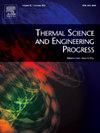Solar-assisted chemical looping gasification system for direct reduced iron production: System design and thermodynamic analysis
IF 5.1
3区 工程技术
Q2 ENERGY & FUELS
引用次数: 0
Abstract
The iron and steel industry is a major source of global CO2 emissions, necessitating the development of low-carbon ironmaking technologies. This study proposes a solar-assisted chemical looping gasification (CLG) system integrated with direct reduced iron (DRI) production (CLG-solar-DRI). Biomass-derived syngas serves as a reducing agent, while iron-based oxygen carriers facilitate chemical looping syngas production. Solar thermal energy compensates for the endothermic nature of gasification, ensuring an efficient heat supply. The generated syngas is fed into a shaft furnace for DRI production, and CO2 is captured through an MEA absorption unit. A comprehensive thermodynamic analysis was conducted to evaluate system performance, including detailed energy and exergy distribution, specific energy consumption, and environmental impacts. Simulation results show that the system achieves an energy efficiency of 60.35 %, an exergy efficiency of 43.2 %, and a metallization rate of 93.78 %. The specific energy consumption is estimated at 3537.31 kWh/t-DRI. Additionally, sensitivity analyses on key design parameters (e.g., syngas split ratio and solar heat input) and integration of solar-driven thermal storage further demonstrate the technical viability of the system. The proposed CLG-solar-DRI configuration presents a feasible pathway for renewable-driven, low-carbon steel production.
用于直接还原铁生产的太阳能辅助化学环气化系统:系统设计和热力学分析
钢铁工业是全球二氧化碳排放的主要来源,因此需要发展低碳炼铁技术。本研究提出了一种太阳能辅助化学环气化(CLG)系统与直接还原铁(DRI)生产(CLG-solar-DRI)集成。生物质衍生合成气作为还原剂,而铁基氧载体促进化学环合成气的生产。太阳能热能补偿了气化的吸热性质,确保了高效的供热。产生的合成气被送入竖炉用于DRI生产,二氧化碳通过MEA吸收装置被捕获。进行了全面的热力学分析,以评估系统的性能,包括详细的能源和火用分布、比能耗和环境影响。仿真结果表明,该系统的能量效率为60.35%,火用效率为43.2%,金属化率为93.78%。具体能耗估计为3537.31 kWh/t-DRI。此外,对关键设计参数(如合成气分解比和太阳能热输入)的敏感性分析以及太阳能驱动储热的集成进一步证明了该系统的技术可行性。提议的CLG-solar-DRI配置为可再生驱动的低碳钢生产提供了一条可行的途径。
本文章由计算机程序翻译,如有差异,请以英文原文为准。
求助全文
约1分钟内获得全文
求助全文
来源期刊

Thermal Science and Engineering Progress
Chemical Engineering-Fluid Flow and Transfer Processes
CiteScore
7.20
自引率
10.40%
发文量
327
审稿时长
41 days
期刊介绍:
Thermal Science and Engineering Progress (TSEP) publishes original, high-quality research articles that span activities ranging from fundamental scientific research and discussion of the more controversial thermodynamic theories, to developments in thermal engineering that are in many instances examples of the way scientists and engineers are addressing the challenges facing a growing population – smart cities and global warming – maximising thermodynamic efficiencies and minimising all heat losses. It is intended that these will be of current relevance and interest to industry, academia and other practitioners. It is evident that many specialised journals in thermal and, to some extent, in fluid disciplines tend to focus on topics that can be classified as fundamental in nature, or are ‘applied’ and near-market. Thermal Science and Engineering Progress will bridge the gap between these two areas, allowing authors to make an easy choice, should they or a journal editor feel that their papers are ‘out of scope’ when considering other journals. The range of topics covered by Thermal Science and Engineering Progress addresses the rapid rate of development being made in thermal transfer processes as they affect traditional fields, and important growth in the topical research areas of aerospace, thermal biological and medical systems, electronics and nano-technologies, renewable energy systems, food production (including agriculture), and the need to minimise man-made thermal impacts on climate change. Review articles on appropriate topics for TSEP are encouraged, although until TSEP is fully established, these will be limited in number. Before submitting such articles, please contact one of the Editors, or a member of the Editorial Advisory Board with an outline of your proposal and your expertise in the area of your review.
 求助内容:
求助内容: 应助结果提醒方式:
应助结果提醒方式:


